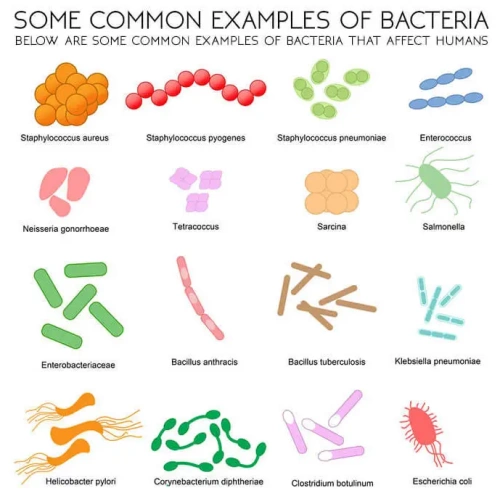Bacteria - Introduction, Morphology, Size, Shape, Arrangement
Introduction to bacteria
Bacteria are prokaryotic, mostly free-living, single-cell organisms that are ubiquitous in nature. They were one of the first forms of life on Earth and inhabited the soil, water, deep biosphere, acidic hot springs, and radioactive waste. They have mutualistic, commensal, and parasitic relationships with plants and animals in their environment.
Bacteriology is a branch of microbiology that studies bacteria. It is important to identify bacteria on the basis of morphology, biochemistry, culture requirements, molecular, and serotypes and group them into taxonomic groups i.e. genus.

Bacteria morphology (Source: Cleveland Clinic)
Morphology of bacteria
Size
Bacteria are minute microscopic organisms measuring approximately 0.5 to 1.0 µm in diameter. Although they are small in size, the surface area/surface volume ratio of bacteria is exceedingly high in comparison to the same ratio for larger organisms of similar shape.
Through their large surface, large amounts of nutrients can enter or waste products can be excreted out compared to a small amount of nourishment required for bacterial cells. This property of bacterial cells in turn accounts for the high metabolism and growth rate of bacteria.
In addition, due to the high surface area/volume ratio, the target for nourishment is close to the surface. Hence, no circulatory system is required for distribution – with little to no cytoplasmic movement in the bacterial cell.
One major downside of a high surface area/volume ratio is the limited size of bacteria.
Shape
Bacterial cells are provided their cell shape and structure by their rigid cell wall. Typically, bacteria are spherical (cocci; singular coccus), straight rods (bacilli; singular bacillus), and helically curved (spirilla; singular spirillum). However, some bacteria exhibit pleomorphic shapes i.e. variety of shapes.

Source: Botman
Arrangement
The arrangement of bacterial cells can be used to group them into particular species – although not all cells of a species are arranged in the same manner. Since arrangement is predominant in bacterial species, it is an important feature.
The formation of the cocci arrangement depends on the plane of cellular division and whether daughter cells stay together after cell division.
Bacilli mostly occur in pairs (diplococci) but in some species (eg: Bacillus subtilis), they form chains (streptobacilli). In genera such as Beggiatoa and Saprospira, they form trichomes. Trichomes and chains are similar but they have a larger area of contact between adjacent cells. In the pathogenic bacteria Corynebacterium diphtheriae, the bacterial cells are lined side by side (palisade arrangement) and are aligned with one another.
In other bacterial species, long-branched multinucleate filaments called hyphae – which collectively form a mycelium – are formed. E.g.: Streptomyces spp.
Some bacteria are curved with a twist. If a bacterial species displays less than one complete curl, it is said to be vibroid in shape. On the other hand, those with one or more complete turns have a helical shape. Eg: Sprilla is rigid helical bacteria while spirochetes are highly flexible.